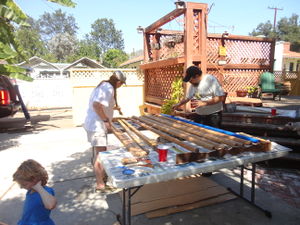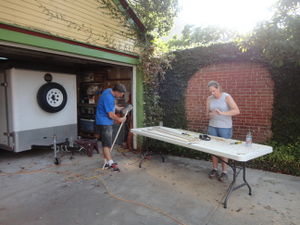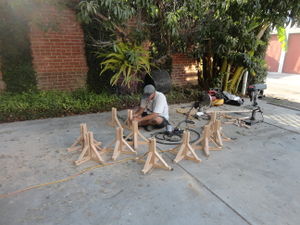Gonfalon Project
Background
Inspired by a desire to simultaneously beautify Caid and answer the eternal question "What are we going to present at PhelanLeBlanc Anniversary next week?," the Barons of Gyldenholt (Giuseppe Francesco da Borgia and Giles Hill) created the Gyldenholt Gonfalon Project, with the ambitious goal of presenting every Barony with two gonfalons bearing that Barony's arms.
Definition
Gonfalons (from the early Italian word confalone) are a type of heraldic flag or banner, often pointed, swallow-tailed or bearing several streamers along the bottom, and suspended from a crossbar in an identical manner to the ancient Roman vexillum. They were first adopted by Medieval Italian communes, and later adopted by local guilds, corporations and districts. The difference between a gonfalon with long tails and a standard is that the gonfalon displays a device on the non-tailed area, while the standard displays badges down the entire length of the flag. (Source: Gonfalon)
Specifications for Our Gonfalons
The finished dimensions for these gonfalons are 20" by 23" (not including the loops at the top of the banner). Lord Dafydd ap Tomas designed the pole and base, and created a downloadable gonfalon banner plan for their construction.
Gonfalons for Caid's Baronies
-
Altavia: Argent, a fret sable and on a chief vert a laurel wreath argent.
-
Three Gyldenholt gonfalons: Azure, a hurst within a bordure Or"
-
Naevehjem: Quarterly argent, ermined gules, and sable, in bend sinister two annulets Or, overall a laurel wreath vert.
-
Calafia: Azure, a sea serpent ondoyant-emergent sable, fimbriated Or, overall a trident with a laurel wreath entwined in its tines or.
More to follow. . .
Gonfalon Production Gallery
-
Celebrate! Lady Staeina finishes the first gonfalon.
-
Mistress Ceara taking a moment's break.
-
Lord Tomas and Astrid work on a base assembly.
-
Lady Juliana and Lord Sigbiorn Sigmundarson staining poles.
-
Lady Juliana and Lord Sigbiorn stain poles while Lady D'vorah bint Dā'ūd works inside the garage.
-
Barone Giuseppe Francesco da Borgia and Lady Juliana
-
Lord Tomas
-
Mistress Ceara
Please report any errors or omissions to Giles.














